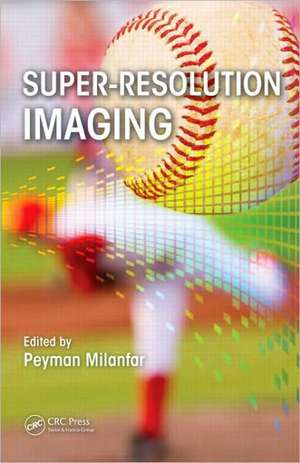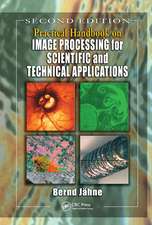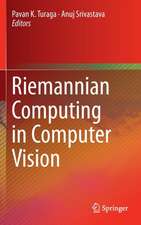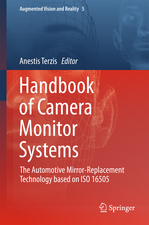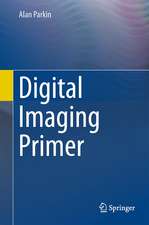Super-Resolution Imaging: Digital Imaging and Computer Vision
Editat de Peyman Milanfaren Limba Engleză Hardback – 28 sep 2010
Features downloadable tools to supplement material found in the book
Recent advances in camera sensor technology have led to an increasingly larger number of pixels being crammed into ever-smaller spaces. This has resulted in an overall decline in the visual quality of recorded content, necessitating improvement of images through the use of post-processing. Providing a snapshot of the cutting edge in super-resolution imaging, this book focuses on methods and techniques to improve images and video beyond the capabilities of the sensors that acquired them. It covers:
- History and future directions of super-resolution imaging
- Locally adaptive processing methods versus globally optimal methods
- Modern techniques for motion estimation
- How to integrate robustness
- Bayesian statistical approaches
- Learning-based methods
- Applications in remote sensing and medicine
- Practical implementations and commercial products based on super-resolution
Preț: 993.77 lei
Preț vechi: 1370.55 lei
-27% Nou
Puncte Express: 1491
Preț estimativ în valută:
190.15€ • 199.07$ • 157.34£
190.15€ • 199.07$ • 157.34£
Carte tipărită la comandă
Livrare economică 05-19 aprilie
Preluare comenzi: 021 569.72.76
Specificații
ISBN-13: 9781439819302
ISBN-10: 1439819300
Pagini: 496
Ilustrații: 163 b/w images, 13 tables and over 400 equations
Dimensiuni: 156 x 234 x 30 mm
Greutate: 0.84 kg
Ediția:1
Editura: CRC Press
Colecția CRC Press
Seria Digital Imaging and Computer Vision
Locul publicării:United States
ISBN-10: 1439819300
Pagini: 496
Ilustrații: 163 b/w images, 13 tables and over 400 equations
Dimensiuni: 156 x 234 x 30 mm
Greutate: 0.84 kg
Ediția:1
Editura: CRC Press
Colecția CRC Press
Seria Digital Imaging and Computer Vision
Locul publicării:United States
Public țintă
Researchers and technicians in image and video processing and computer vision, computer science, and applied mathematics; including electrical and industrial engineersCuprins
Image Super-Resolution: Historical Overview and Future Challenges. Super-Resolution Using Adaptive Wiener Filters. Locally Adaptive Kernel Regression for Space-Time Super-Resolution. Super-Resolution With Probabilistic Motion Estimation. Spatially Adaptive Filtering as Regularization in Inverse Imaging. Registration for Super-Resolution. Towards Super-Resolution in the Presence of Spatially Varying Blur. Toward Robust Reconstruction-Based Super-Resolution. Multi-Frame Super-Resolution from a Bayesian Perspective. Variational Bayesian Super Resolution Reconstruction. Pattern Recognition Techniques for Image Super-Resolution. Super-Resolution Reconstruction of Multi-Channel Images. New Applications of Super-Resolution in Medical Imaging. Practicing Super-Resolution: What Have We Learned?
Notă biografică
Peyman Milanfar is Professor of Electrical Engineering at the University of California, Santa Cruz. He received a B.S. degree in Electrical Engineering/Mathematics from the University of California, Berkeley, and the Ph.D. degree in Electrical Engineering from the Massachusetts Institute of Technology. Prior to coming to UCSC, he was at SRI (formerly Stanford Research Institute) and served as a Consulting Professor of computer science at Stanford. In 2005 he founded MotionDSP, Inc., to bring state-of-art video enhancement technology to consumer and forensic markets. He is a Fellow of the IEEE for contributions to Inverse Problems and Super-resolution in Imaging.
Descriere
This book functions as the definitive overview of the field of super-resolution imaging. Written by the leading researchers in the field of image and video super-resolution, it surveys state-of-the-art techniques, and each detailed chapter covers the implementations and applications of super-resolution imaging. Its 14 sections span a wide range of modern super-resolution imaging methods and includes variational, Bayesian, feature-based, multi-channel, learning-based, locally adaptive, and nonparametric methods. It discusses, among others, medical, military, and remote-sensing applications. The book can be used as a reference, a basis for short courses on the subject, or as part of a graduate course on digital image processing.
